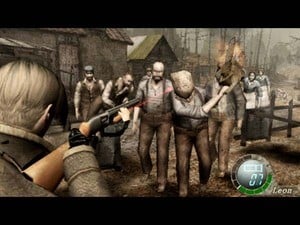
Halloween is upon us. We've been celebrating Spook Month for the past thirty-one days, with reviews of frightening or fright-themed retro games every Friday and Saturday, and after a good bout of trick-or-treating or dressing up to go to Rocky Horror, we'll be sitting down to some of our favourites that make us cringe, jump and shudder. But why do these titles have this effect? We could list every frightening title or go on and on about the immersive graphics and engrossing soundscapes of our favourite horror games, those aesthetic elements that suck us in and make us feel what the character feels all the more, but that's not what we're after here. In this article, we are after fear's very essence.
"People often prefer fearful reality to fearful fantasy." – Joost A.M. Meerloo, M.D.¹
Fear is usually explained in biological terms as the body's response to something that may cause it harm or death. We flinch when we hear a loud sound, presumably because it suggests nearby danger, for example. How, then, do we explain fear of something, say, a video game, that we know has no chance of physically hurting us?
There's a lot tied up with the idea of death – the afterlife or lack thereof, the regret of having not accomplished, the looking back on one's life and assessing its successes and failures, the mourning that will fill the void we've left behind. Thus, a game character's death is not precisely analogous to the death of the player who controls it. The death of a character is not even necessarily the ceasing of life, for a player can easily just begin a new file or return to a save point. If only when we died in real life, we were presented with a YOU DIED screen a la Resident Evil and given the option to continue from our last save. And who's to say that we aren't?
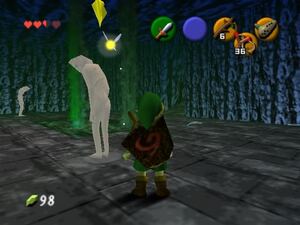
Perhaps the closest analogy to physical death in a game, then, is erasure, the destruction of progress. How upset do we get when a little brother decides to find out what that little red button on the Wii does when we happen to be in the middle of a game? Even when someone walks between us and the T.V., we become irritated. How dare they put us at such risk? If, in real life, we died in some accidental way, our disembodied souls might look down on the scene and scream, "No fair! How could you kill me? I was right about to [insert goal to accomplish]!" How many of us have thought of dying with the attached idea of not reading or writing that book, finding that love or eating that meal we'd been looking forward to or towards which we'd been working?
This is why we fortify ourselves against such progress-erasing risks. We go in our room and shut the door. We play when the least distracting combination of elements accumulates around us. When the four-year-old nephews are over, we play Wii Party, not Monster Hunter 3 (Tri~). This is partly because we do not want them to interrupt our concentration or distract us, but the other half is fear. We are afraid for our game files, afraid of losing our progress. This is the same reason why we only buy first-party memory cards and why touching the power button while a game saves seems not only foolish to us but simply unthinkable. We refuse to accept this possibility, we fear this possibility, we grow angry or irritated toward those who increase this possibility and at ourselves for not trusting that original fear. We fear for our files, and we mourn their loss.
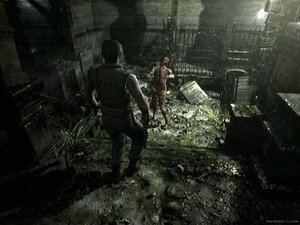
Eternal Darkness: Sanity's Requiem was unique for a number of reasons, but only one of them warranted a U.S. patent – the sanity meter. We'd expect that seeing the things that its characters see would drive us a bit mad if we saw them in real life – demons, beasts and monsters who lurk in the dark inner mechanisms that manipulate the mundane world – and our characters' loss of sanity as a result of viewing them brings us a bit closer to that reality. When we begin to experience the insanity, however, it's often more cool than frightening or maddening, and even a bit humorous. Certainly the loud noises shock us and whispers spook us, but when our cranium pops off and we pilot our headless body, approaching our stray noggin as the action "Replace Head" flashes onto the screen, it's just funny.
What's not so funny, however, is when the game channels this fear of erasure and has our character hallucinate what we, as gamers, dread most. When we go to save, it asks us, "Are you sure you want to erase your file?" with the options "Yes" and "Continue without saving". We of course pick the latter, though the two options turn out to do the same thing, and worriedly watch the status bar of our save files' destruction. "It's ok," we tell ourselves, half-believing it. "It's just a sanity effect." Complete, we are returned to the main menu... and flash! Back in the game. What relief we feel as the fear diminishes, but not so much as to leave us completely unshaken.
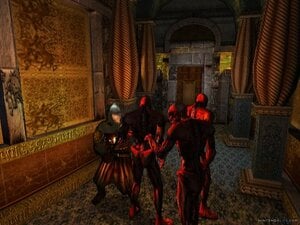
At other times, the T.V. itself will appear to turn off, or the volume will turn down all the way, channelling a host of fears – is someone else in the room? IS THE TELEVISION REMOTE HAUNTED?! A bit of us may even recall those times when our four-year old cousins run about, threatening to end everything for which we'd worked.
Perhaps more tension inducing is a factor that has nothing to do with sanity effects whatsoever – that which results from not being able to save when danger lurks. Whenever a threat shares the room with our character, when we are most afraid of losing our progress, the black text of the pause-menu Save button greys over and we are forced to fight it out before assuring the well-being of our save files.
But Resident Evil is undeniably the reigning king of game-save restrictions. What first seems obnoxious and cumbersome – the obligation to collect ink ribbons for use in typewriters to record your progress – becomes a catalyst for terror as the stakes ramp up higher and higher. Especially in more difficult modes, when ammo is scarce and zombies are more fierce, lethal and tough than ever, every enemy defeated is a difficult task accomplished, every blind corner and unidentifiable sound is a possible threat, and every typewriter is a temptation. But a ribbon used may be a ribbon wasted, as running out would become the ultimate nightmare. And with every moment between saves, which necessarily outgrow a player's comfort level, the risk of progress erasure grows ever stronger, ever fiercer, ever more threatening.

Another way that a game can get underneath our skin is by bringing ourselves closer to its characters. It's tough to identify with an indefatigable Duke Nukem, but what of an average guy? Harry Mason of Silent Hill: Shattered Memories could easily be any one of us. Of course, someone much younger or of a different gender will have an extra step to cross, but it's a small step; Harry is a regular human being trying to save someone about whom he cares. This game also takes it one step further – Harry has no weapons. Think about it, and be honest with yourself: if surrounded by such disturbing monsters as that which surround you in Silent Hill, would you fight back? You might, if you had the training of a soldier or the self-delusion to identify yourself with your favourite video game or action movie star, but an average person's first instinct would not be to fight back. It would be to freeze, or to run. That's all that Harry can do. And it's terrifying.
Harry can die, however, as can any other video game character, and mostly it's inconvenient, requiring a simple return to an old save file as discussed above. But a physical death is not the only death to which a person can succumb. People can die inside, as well. Spoiler Alert: One scene in Shattered Memories sees Harry try to help a woman with a head injury by helping her get to sleep. We feel terror as we predict Harry's blunder, and the guilt washes over us as we are already one with Harry. We want him to stop; we cannot stop. The woman, of course, dies. "It's not what it looks like!" we say. We fear the moral death of the character, the others judging him to be less than human, even if the people doing the judging aren't real themselves.
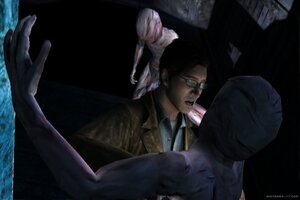
In Eternal Darkness as well, you at one point play as a character who suspects that his servants are possessed by demons. Even in spite of the mystical context, it's horrifying to watch as he goes about slaughtering them – and even more disturbing that you're in control. </spoiler>
Similarly, how often in the innocent Super Mario RPG are we asked to perform an action on behalf of an eager youngster, and why, for some of us, is it unthinkable to tell them "No, I won't help you out"? Why do we fear for how other characters see Mario? Even if we get to see more of a game or though part of us might find it funny to act like a jerk, another part of us fears what others might think, others who, again, are far from real.
In the beginning of The Legend of Zelda: The Wind Waker, we are caught off-guard by the kidnapping of the hero's little sister, to whom we have become somewhat attached or at least endeared. Why do we fear for her? We've gotten to know her, if even just a little bit; she's more real to us than the average damsel in distress, who we sometimes only hear about, not interact with, before we must rescue; and, of course, she's a helpless little girl. And we're her big brother. Also, she's been carried off by a bird, and if science has taught us anything it's that birds have no morals.

Perhaps the most fearsome thing is that we are expected to face the danger. Often it is somewhat overwhelming, pressing in upon us – the responsibility to our little sister, to our daughter, to ourselves. Not to mention the physical claustrophobia of tight hallways in Resident Evil or the intimidating, vast inky blackness of Silent Hill: Shattered Memories. We alone must keep our sanity and not panic. The monsters we face, when crafted by a skilful designer, amass in great numbers and overwhelm us, refuse to die, refuse to let up. They are inhuman yet too human, somewhere between mutations and automatons, channelling our senses of the sublime and the horrifying, the dead and the living, the unknown and that which can never be known, all at once, showing us enough to be afraid and letting us imagine the rest, filling in the murky spots with what we fear most and yet cannot imagine. Tension mounts and that which is redolent of the darkness shows itself through the cracks in the walls. This is the tension of the shadowy, clinking hallways of Resident Evil, the frozen bedrooms of Silent Hill: Shattered Memories, the horrible shadows of Dead Space Extraction that hide men who look and sound like they once were human but move like corpses and cockroaches, and the whispers of Eternal Darkness, the gaps that are shadows that silently conceal screams and may mask nightmares, and we are told we must continue. Between the stillness and the swarm, fear seeps in.
When overwhelmed by fear before we have time to feel afraid, fear becomes panic. Panic comes easy to life but not to video games, which is why forgetting that you're playing a game – through it breaking the fourth wall, leading you to identify with a character or enveloping you in high-quality ambient effects – is integral to fear inducement.
Being chased can induce panic as well. Video game characters have been getting chased since the ghosts of Pac-Man. Tetris is a classic and elegant example; we work hard as the tension and speed gradually mount and feel panic as it all comes to a crashing end. The Japan-only Tetris 64 would channel this by asking you to insert a bio sensor in your ear. The more panicked you became, the quicker the blocks would fall. Nintendo has since announced the development of the Wii Vitality Sensor, which Iwata suggested would help look into someone's "inner world," though they've since downplayed coverage of the peripheral and have yet to demonstrate its exact purpose – but the idea of utilising the connection between one's felt tension and the events of a game speaks volumes. Resident Evil introduced the Tyrant, who chases you through the B story of Resident Evil 2 and the entire city in Resident Evil 3: Nemesis. We feel fear when the alarms go off in GoldenEye 007 and we know that soon, guards will chase us, their guns sometimes disturbingly poking through the walls of certain stages. In Legend of Zelda titles like Ocarina of Time and The Wind Waker, we are paralysed, grasped and held by surrounding shuffling zombie-like ReDeads, and we can almost feel the tightness of their engulfing limbs. And in Resident Evil 4 the entire village would chase Leon in droves. Droves with chainsaws.
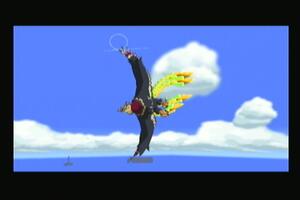
Though this same panic need not be set off by zombies or beasts. What of the beeping of Link's hideous final heart? What of making it to world 8 of Super Mario Bros., the hardest of them all, with just one life left? What of the quiet steps you take with impulsive slowness towards the final boss? Fear is an integral part of gaming; with greater progress comes an increased risk of loss, with fear of this loss comes tension and panic. We can be courageous in a video game because our character will live again, awakened at the last save point. But one would never be so courageous if that character had your memory card in his or her pocket.
How rational is fear? We fear, quite often, that which will never harm us. We fear the dark, we fear heights, we fear flying, we fear public speaking. It's no small wonder, then, that we fear occurrences that take place in video games. As we've demonstrated, while a Resident Evil or a Silent Hill will go out of its way to frighten you, you don't need to be playing a horror game to feel horror.
But it helps.
1. Meerloo, Joost A.M., M.D. Patterns of Panic. New York: International Universities Press, 1950. Page 23.
Comments 41
BOO! Did I scare ya?
Those re-deads from Zelda were scary as heck when I was little.
the ReDeads in Wind waker are really creepy imo
I thought the Redeads in Wind Waker were far worse. They made my ears bleed
The lake monster in Resident Evil 4....shiver. This was a great read. Thanks Mr. NECRONOMIKaplan!
I hate ReDeads...
Wallmasters scare the sh*t out of me.
I would like to see a horror game where some monsters would turn more powerful if you attacked them. That would be frightening, like in nightmare where your resistance against some beings is just completely futile.
Great article.
The Re-Deads in TLoZ:OoT were really scary, with the sound and all...
Nice article. This following treat is not really scary but here ya go: http://www.youtube.com/watch?v=qvzdacISqt4 Happy Halloween, NL! =)
@ # 2: the redeads from ocarina of time are still scary as heck, and im 15....
Yeah, I really liked this article. Probably the scariest thing Ive ever had in a game is playing Eternal Darkness. It said I could examine the bathtub and when I did, it flashed real fast to your dead body in a pool of blood. It was creepy stuff.
@12
It's a good game with awesome atmosphere, that I can tell from Oventure. I'm stuck though! I really should just read a guide... But yeah, it would fit the Wii like a glove.
Great text anyway! It really makes me want to try Eternal Darkness! The W2(WII) can't come soon enough, featuring a shop channel GC games for download! Just imagine all the GC rares at low low prices...
I hope that the Wii Vitality Sensor or something like it for a coming system is used in a Zelda game. Inside the Great Deku Tree still scares me a little, and Nintendo taking advantage of my fear would be great. wait what
Man, reading this reminds me that I really want to be in a band before I pop my clogs! I also have back-up memory cards of all of my old GameCube memory cards for fear of losing those precious saves and this article is spot-on, I only bought the first-party cards too!
I really like the idea of linking the Vitality Sensor to a tense moment in a game, to heighten the mood and fear-factor.
A menacingly wicked feature Zach, great stuff!
I've been working on a story for a video game, it's a survival horror, and this article here was very educational. THANK YOU.
What made the redeads so scary was the fact that they can increase panic by completely freezing your character. They moved at a snails pace, but the fact that their screams froze you as they slowly inched closer was VERY panicking and disturbing.
Without getting too religious, I genuinely feel that Eternal Darkness is more than a game. It feels very demonic just powering that game on. My scariest moment playing the game was when I turned up the volume and one of the characters was going insane from what he saw and began screaming loudly and all the electricity went out in my house. I never turned that game on again.
I've never been scared by a video game but I do think Resident Evil and Shattered Memories come the closest because of the ink ribbons in the former and lack of weapons in the other.
Usually in video games you are immortal (via continues, saves and re-starting) and armed to the teeth. Because the ink ribbons in Resident Evil are scarce, you try to go as long as you can without saving, which can lead to a lot of progress being lost if you make a mistake. Resident Evil has weapons, however, and Shattered Memories does not. There you're also not scared so much of the monsters themselves, but panic so as not to get lost, losing your life as a result.
I think these games also do well to give an errie atmosphere, but they still fail to produce fear as, say, a horror movie would where the character will have one life and you have no control over what they are doing. It's the "no, don't run up the stairs!" thing that's lost in games because you can literally just choose not to go up those stairs - or at least wait until you've stocked up enough ammo first.
I do have to point out that after playing Shattered Memories, I hope more games adopt the no weapons aproach. I love my shoot-em-ups, but I found exploring a eerie town with nothing but a flashlight to use much more interesting and exciting. Combat can sometimes take away from the exploration - you shouldn't have to fight in every game you play, it's nice to have a change.
The ReDeads were creepy in Zelda games. But perhaps even more annoying was that annoying Wallmaster.
The biggest fear in games is being taken through a long, difficult and frustrating area and being left low on health with no sign of a save point. You're scared of dying before being able to save and having to do it all over again.
Amnesia deserves to be there.
@12
I looked up Penumbra and you're right! Would work beautifully on Wii. I also read that the developer considered it, but figured it would be more trouble than good.
Yeah I agree about the Zelda games. While the ReDeads were indeed creepy, the Wallmasters always managed to induce panic, for fear of both it touching me and having to restart the dungeon from the first room.
Interesting read here, thanks. There ought to be more of this type of editorial feature on NL. It keeps the personality of the site more vibrant.
The writing is not very well polished here, but I mean no offense, it's still nice to have the commentary and to have dedicated writers. The more of it there is the more incentive people have to come here instead of other game sites and the writing just gets better.
The original Resident Evil was the only memory I have of being scared by a game like a great horror movie might. Shattered memories captured a little of that too. It really only works like cinematic suspense does with movies, often relying on great sound design to catch you off guard after lulling you into a quiet place where you are searching for someting with little to do then, BAM! Zombie out of a closet. It was awesome for a video game to have that for the first time, and have you slamming buttons in a panic, I'll never forget that first RE play through in my dark apartment in an attic back then.
intresting...
how did you guys not mention Moon (DS)?
especially if you bothered to read the logs scattered throughout the game, it could give you a pretty good chill
Running out of Ammo in the late part of RE4 was fun! I sold the game and quit playing it... problem solved
You forgot the ghosts in Pokemon Tower.

Get out..... Get out.....
Hmm...
I can't say that I agree with external gaming mechanics making the game scary. I can't really put into words what makes for a good scary game. However, these guys seem to do a good job of explaining it.
You know whats scary? Letting a little kid play with your DS only to find out a Pokemon game is in there. /heartattack
Scary is: Poking a new game on your Wii waiting for the game to appear on the Disc channel while praying for it not to be double layered. It felt horrible with M:OM .
What a great feature, NL is doing great with these.
@beachfan888
I hate that site, one time the site and ALL its members were saying Miyamoto was overrated and didn't deserve his recognition.
I'm glad that those of you who liked the article did, I had fun writing it. And sorry that I couldn't include others' favorite horror game - maybe next year we'll do part 2?
I restarted loz ww but I never finished cause I didn't want to go back to the redead part...
I really want to get alan wake now.
You got to love RE.
If I was older I would try some of these games out, but you don't need an adult game to feel fear as the article pointed out. It was very long but I'm pleased I read it all, and it was certainly interesting. I think one of the scariest things in videogames is when you have to turn a corner or open a door or enter a room, with no idea what could be waiting to pounce on you.
I've never played a fear inducing game and I've never wanted to... But those ReDeads in OoT and WW... OMG, those things are horrible. D:
They scream, you freeze for what feels like 2 hours as they inch closer and closer ready to tear the skin off of your bones... even though I'm 17 and I know full well those things can't get me, it still gets my heart pumping...
@33 You can't expect us to wait a whole year! We want it nao! D:
I've played many of the games on that list, and although they all had their moments, I never felt afraid so much as "man... I bet I'm going to walk around the corner and get destroyed by something that jumps out at me and then have to replay everything I just did". It was still effective for raising tension, but other than maybe a few choice moments I wouldn't call it scary. Fatal Frame, on the other hand, scares the crap out of me. My biggest fear as a kid was ghosts (anyone played Haunted House for Atari 2600? That game was terrifying when I was 5), and even now that I'm grown up and know how irrational that fear is I just can't get myself to sit down to try to finish that game. Which is kind of sad because that's kind of the entire point of playing a survival horror game, so they must be doing something right.
Wind waker instead of Majora's Mask ?!!!!......I get the joke. xD
@kurtasbestos
A wii remake of Haunted House just came out. For 20 bucks!!
re4 was the best game ever!!!!!!
Tap here to load 41 comments
Leave A Comment
Hold on there, you need to login to post a comment...